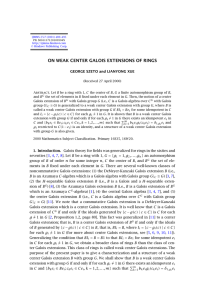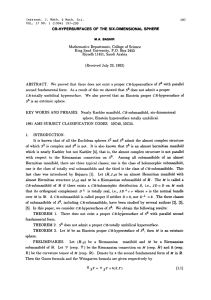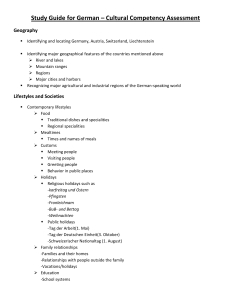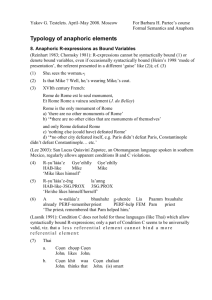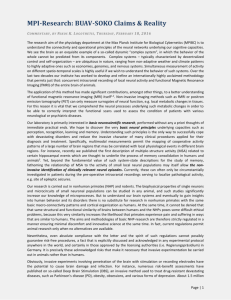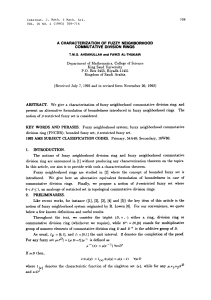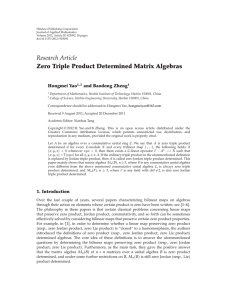THE BOOLEAN ALGEBRA OF GALOIS ALGEBRAS George Szeto and Lianyong Xue
advertisement
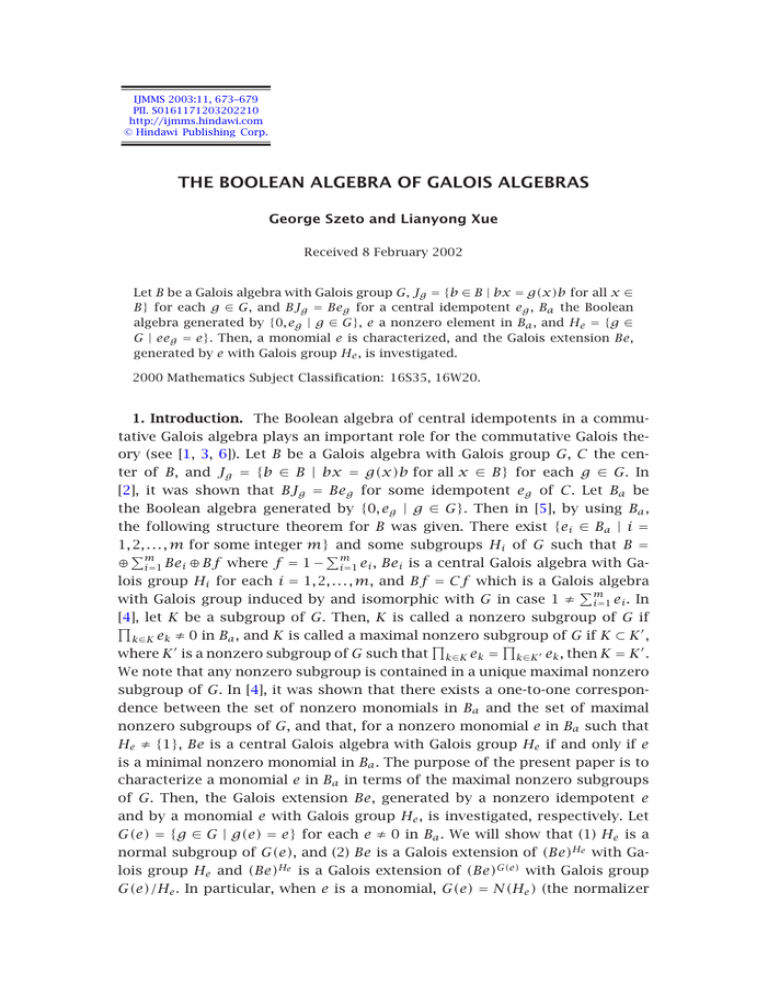
IJMMS 2003:11, 673–679
PII. S0161171203202210
http://ijmms.hindawi.com
© Hindawi Publishing Corp.
THE BOOLEAN ALGEBRA OF GALOIS ALGEBRAS
George Szeto and Lianyong Xue
Received 8 February 2002
Let B be a Galois algebra with Galois group G, Jg = {b ∈ B | bx = g(x)b for all x ∈
B} for each g ∈ G, and BJg = Beg for a central idempotent eg , Ba the Boolean
algebra generated by {0, eg | g ∈ G}, e a nonzero element in Ba , and He = {g ∈
G | eeg = e}. Then, a monomial e is characterized, and the Galois extension Be,
generated by e with Galois group He , is investigated.
2000 Mathematics Subject Classification: 16S35, 16W20.
1. Introduction. The Boolean algebra of central idempotents in a commutative Galois algebra plays an important role for the commutative Galois theory (see [1, 3, 6]). Let B be a Galois algebra with Galois group G, C the center of B, and Jg = {b ∈ B | bx = g(x)b for all x ∈ B} for each g ∈ G. In
[2], it was shown that BJg = Beg for some idempotent eg of C. Let Ba be
the Boolean algebra generated by {0, eg | g ∈ G}. Then in [5], by using Ba ,
the following structure theorem for B was given. There exist {ei ∈ Ba | i =
1, 2, . . . , m for some integer m} and some subgroups Hi of G such that B =
m
m
⊕ i=1 Bei ⊕ Bf where f = 1 − i=1 ei , Bei is a central Galois algebra with Galois group Hi for each i = 1, 2, . . . , m, and Bf = Cf which is a Galois algebra
m
with Galois group induced by and isomorphic with G in case 1 ≠ i=1 ei . In
[4], let K be a subgroup of G. Then, K is called a nonzero subgroup of G if
k∈K ek ≠ 0 in Ba , and K is called a maximal nonzero subgroup of G if K ⊂ K ,
where K is a nonzero subgroup of G such that k∈K ek = k∈K ek , then K = K .
We note that any nonzero subgroup is contained in a unique maximal nonzero
subgroup of G. In [4], it was shown that there exists a one-to-one correspondence between the set of nonzero monomials in Ba and the set of maximal
nonzero subgroups of G, and that, for a nonzero monomial e in Ba such that
He ≠ {1}, Be is a central Galois algebra with Galois group He if and only if e
is a minimal nonzero monomial in Ba . The purpose of the present paper is to
characterize a monomial e in Ba in terms of the maximal nonzero subgroups
of G. Then, the Galois extension Be, generated by a nonzero idempotent e
and by a monomial e with Galois group He , is investigated, respectively. Let
G(e) = {g ∈ G | g(e) = e} for each e ≠ 0 in Ba . We will show that (1) He is a
normal subgroup of G(e), and (2) Be is a Galois extension of (Be)He with Galois group He and (Be)He is a Galois extension of (Be)G(e) with Galois group
G(e)/He . In particular, when e is a monomial, G(e) = N(He ) (the normalizer
674
G. SZETO AND L. XUE
of He ), and when e is an atom (a minimal nonzero element) of Ba , Be is a central
Galois algebra over Ce with Galois group He and Ce is a commutative Galois
algebra with Galois group G(e)/He . This generalizes and improves the result
of the components of B in [5, Theorem 3.8] for a Galois algebra.
2. Definitions and notations. Let B be a ring with 1, C the center of B, G
an automorphism group of B of order n for some integer n, and B G the set
of elements in B, fixed under each element in G. B is called a Galois extension
of B G with Galois group G if there exist elements {ai , bi in B, i = 1, 2, . . . , m}
m
for some integer m such that i=1 ai g(bi ) = δ1,g for each g ∈ G. B is called
a Galois algebra over R if B is a Galois extension of R which is contained in
C, and B is called a central Galois extension if B is a Galois extension of C.
In this paper, we assume that B is a Galois algebra with Galois group G. Let
Jg = {b ∈ B | bx = g(x)b for all x ∈ B}. In [2], it was shown that BJg = Beg
for some central idempotent eg of B. We denote (Ba ; , ·), the Boolean algebra
generated by {0, eg | g ∈ G}, where e · e = ee and e e = e + e − ee for any
e and e in Ba . An order relation ≤ is defined as usual, that is, e ≤ e in Ba
if e · e = e. Throughout, e + e , for e, e ∈ Ba , means the sum in the Boolean
algebra (Ba ; , ·), He = {g ∈ G | e ≤ eg } for an e ≠ 0 in Ba , and a monomial e in
Ba is g∈S eg ≠ 0 for some S ⊂ G.
3. The Boolean algebra. In this section, we will characterize a monomial e
in Ba in terms of the maximal nonzero subgroups of G. We begin with several
lemmas.
Lemma 3.1. Let {ei , f | i = 1, 2, . . . , m} be given in [5, Theorem 3.8]. Then,
(1) {ei , f | i = 1, 2, . . . , m} is the set of all minimal elements of Ba in case
f ≠ 0,
(2) for each e ≠ 0 in Ba , there exists a unique subset Ze of the set {1, 2, . . . , m}
such that e = i∈Ze ei or e = i∈Ze ei + f .
Proof. (1) By the proof of [5, Theorem 3.8], either ei = g∈Hi eg , where
Hi is a maximum subset (subgroup) of G such that g∈Hi eg ≠ 0, or ei = (1 −
t
g∈Hi eg for some t < i, where Hi is a maximum subset (subgroup) of
j=1 ej )
t
G such that (1 − j=1 ej ) g∈Hi eg ≠ 0; so, either ei is a minimal element of Ba
t
or ei is a minimal element of (1− j=1 ej )Ba . Noting that any minimal element
t
in (1− j=1 ej )Ba is also a minimal element in Ba , we conclude that each ei is a
minimal element in Ba . Next, we show that f is also a minimal element of Ba in
case f ≠ 0. In fact, by the proof of [5, Theorem 3.8], eg f = 0 for any g ≠ 1 in G;
so, for any e ∈ Ba , ef = 0 or ef = f . This implies that f is a minimal element
m
of Ba in case f ≠ 0. Moreover, i=1 ei + f = 1; so, {ei , f | i = 1, 2, . . . , m} is the
set of all minimal elements of Ba in case f ≠ 0.
m
(2) Since 1 = i=1 ei + f , a sum of all minimal elements of Ba , the statement
is immediate.
675
THE BOOLEAN ALGEBRA OF GALOIS ALGEBRAS
Lemma 3.2. Let e be a nonzero element in Ba . Then,
(1) there exists a monomial e of Ba such that e ≤ e and He = He ,
(2) He is a maximal nonzero subgroup of G.
Proof. (1) For any nonzero element e in Ba , let e = g∈He eg . We claim
that e ≤ e and He = He . In fact, for any h ∈ He , e ≤ eh ; so, e ≤ h∈He eh = e .
Moreover, for any h ∈ He , eh ≥ g∈He eg = e ; so, h ∈ He . Hence, He ⊂ He .
On the other hand, for any h ∈ He , eh ≥ e = g∈He eg ≥ e; so, h ∈ He . Thus,
He ⊂ He . Therefore, He = He .
(2) By [4, Theorem 3.2], He is a maximal nonzero subgroup of G for e is a
monomial. Hence, He (= He ) is a maximal nonzero subgroup of G.
Next is an expression of He for a nonzero e ∈ Ba .
Theorem 3.3. For any e ≠ 0 in Ba , He = ∩i∈Ze Hei or H1 , where e =
or e = i∈Ze ei + f as given in Lemma 3.1(2).
i∈Ze
ei
Proof. We first show that for e = e +e for some e , e ≠ 0 in Ba , He = He ∩
He . In fact, since e ≥ e and e ≥ e , we have He ⊂ He ∩He . Conversely, for any
g ∈ He ∩ He , eg ≥ e and eg ≥ e ; so, eg ≥ e + e = e. Hence, g ∈ He ; so, He =
He ∩ He . Therefore, by induction, if e = i∈Ze ei , then He = ∩i∈Ze Hei . Now,
by Lemma 3.1, for any e ≠ 0 in Ba , e = i∈Ze ei or e = i∈Ze ei + f . Similarly, if
e = i∈Ze ei + f , then He = H(i∈Ze ei )+f = (∩i∈Ze Hei ) ∩ Hf . But, for g ∈ G such
that eg ≠ 1, eg f = 0; so, Hf = H1 . Therefore, He = (∩i∈Ze Hei ) ∩ H1 = H1 for
H1 ⊂ Hei for each i.
We observe that there exist some e ≠ 0 such that He = ∩i∈Ze Hei and He ⊂ Hej
for some j ∈ Ze , and that not all e ≠ 0 are monomials. Next, we identify which
element e ≠ 0 in Ba is a monomial. Two characterizations are given. We begin
with a definition.
Definition 3.4. An e ≠ 0 in Ba is called a maximal G-element if He ≠ H1
and, for any e ∈ Ba such that e ≤ e and He = He , e = e .
Lemma 3.5. (1) If e ≠ 0 such that ef = 0, then e = i∈Ze ei .
(2) If e is a monomial, e = g∈S eg for some S ⊂ G, then e = 1 or e = i∈Ze ei .
Proof. (1) By Lemma 3.1, e = i∈Ze ei or e = i∈Ze ei + f . If e ≠ i∈Ze ei ,
then e = i∈Ze ei + f and f ≠ 0. But then, f = ( i∈Ze ei + f )f = ef = 0. This is
a contradiction. Hence, e = i∈Ze ei .
(2) In case e = 1, we are done. In case e ≠ 1. Since eg f = 0 for each g ∈ G
such that eg ≠ 1, ef = g∈S eg f = 0. Thus, by (1), e = i∈Ze ei .
Theorem 3.6. Keeping the notations of Lemma 3.1 for any e ≠ 0, 1 in Ba ,
the following statements are equivalent:
(1) e = g∈S eg for some S ⊂ G, a monomial in Ba ;
(2) e is a maximal G-element in Ba ;
676
G. SZETO AND L. XUE
(3) e = i∈Ze ei where {ei | i ∈ Ze } are all atoms such that He ⊂ Hei and
He ≠ H1 .
Proof. (1)⇒(2). Since e is a monomial and e ≠ 1, e = g∈He eg where eg ≠ 1
for some g ∈ He . Thus, He ≠ H1 . Next, for any e such that e ≤ e and He = He ,
e ≤ e ≤
g∈He
eg =
eg = e.
(3.1)
g∈He
Hence, e = e . This implies that e is a maximal G-element in Ba .
(2)⇒(1). Let e be a maximal G-element and e = g∈He eg . Then, by Lemma 3.2,
e ≤ e and He = He . But e is a maximal G-element; so, e = e which is a monomial.
(1)⇒(3). By Lemma 3.5, e = i∈Ze ei . Now, let ej be an atom such that He ⊂
Hej . Then, ej ≤ g∈He eg ≤ g∈He eg . But, by hypothesis, e is a monomial;
j
so, e = g∈He eg . Hence, ej ≤ e. This implies that ej is a term in e. Thus, e =
i∈Ze ei where {ei | i ∈ Ze } are all atoms such that He ⊂ Hei . Moreover, since
e = g∈S eg ≠ 1, there exists g ∈ G such that e ≤ eg ≠ 1. Thus, g ∈ He and
g ∈ H1 . Therefore, He ≠ H1 .
(3)⇒(1). Let e = g∈He eg . Then, by Lemma 3.2, e ≤ e and He = He . Since
He ≠ H1 , He ≠ H1 . Also, since e is a monomial, e = j∈Ze ej by Lemma 3.5(2).
Now, suppose that e ≠ e . Then, there is a j ∈ Ze but j ∈ Ze , that is, ej is a term
of e = j∈Ze ej but not a term of e = i∈Ze ei . But then, He = He = ∩j∈Ze Hej ⊂
Hej such that j ∈ Ze . This contradicts the hypothesis that e = i∈Ze ei where
{ei | i ∈ Ze } are all atoms such that He ⊂ Hei . Thus, e = e which is a monomial
in Ba .
4. Galois extensions. In [5], it was shown that Be is a central Galois algebra
with Galois group He for any atom e ≠ f of Ba . Also, for any e ≠ 0 in Ba ,
Be is a Galois extension of (Be)G(e) with Galois group G(e)|Be G(e) where
G(e) = {g ∈ G | g(e) = e} (see [5, Lemma 3.7]). In this section, we are going
to show that, for any e ≠ 0 in Ba (not necessary an atom), (1) He is a normal
subgroup of G(e), and (2) Be is a Galois extension of (Be)He with Galois group
He and (Be)He is a Galois extension of (Be)G(e) with Galois group G(e)/He . This
generalizes and improves the result for Be when e is an atom of Ba as given in
[5, Theorem 3.8]. In particular, for a monomial e, G(e) = N(He ), the normalizer
of He in G.
Lemma 4.1. Let e ≠ 0 in Ba . Then, He is a normal subgroup of G(e) where
G(e) = {g ∈ G | g(e) = e}.
Proof. We first claim that He ⊂ G(e). In fact, by Lemma 3.1, for any e ≠ 0 in
Ba , there exists a unique subset Ze of the set {1, 2, . . . , m} such that e = i∈Ze ei
or e = i∈Ze ei + f where ei are given in Lemma 3.1. Moreover, for each i,
677
THE BOOLEAN ALGEBRA OF GALOIS ALGEBRAS
t
ei = h∈He eh or ei = (1 − j=1 ej ) g∈He eg for some t < i. Noting that g
i
i
permutes the set {ei | i = 1, 2, . . . , t} for each g ∈ G by the proof of [5, Theorem
3.8], we have, for each g ∈ G,
eh =
eghg−1 ≥
eg eh eg−1 = eg ei eg−1
(4.1)
g ei = g
h∈Hei
h∈Hei
h∈Hei
or
g ei = g
1−
t
j=1
≥ 1−
t
ej
j=1
= eg
1−
ej
ej
Now, in case e =
i∈Ze
t
j=1
ej
eghg−1
h∈Hei
eg eh eg−1
h∈Hei
t
= 1−
h∈Hei
j=1
eh
(4.2)
eh eg−1 = eg ei eg−1 .
h∈Hei
ei , for any h ∈ He ,
e = eh eeh−1 =
i∈Ze
eh ei eh−1 ≤
h ei = h(e).
(4.3)
i∈Ze
Thus, h(e) = e using Lemma 3.1(2). Noting that g permutes the set {ei | i =
1, 2, . . . , m} for each g ∈ G, we have g(f ) = f for each g ∈ G. Thus, we have
h(e) = e for each h ∈ He in case e = i∈Ze ei + f . This proves that He ⊂ G(e).
Next, we show that He is a normal subgroup of G(e). Since for each g ∈ G,
g(ei ) is also an atom, g(e) = e (i.e., g ∈ G(e)) implies that g permutes the set
{ei | i ∈ Ze }. Therefore, for each i ∈ Ze , g(ei ) = ej and gHei g −1 = Hej for some
j ∈ Ze . But, by Theorem 3.3, He = ∩i∈Ze Hei (or He = H1 which is normal); so,
for any g ∈ G(e), gHe g −1 = g(∩i∈Ze Hei )g −1 = ∩i∈Ze gHei g −1 = ∩j∈Ze Hej = He .
Therefore, He is a normal subgroup of G(e).
Theorem 4.2. Let e be a nonzero element in Ba . Then,
(1) Be is a Galois extension of (Be)G(e) with Galois group G(e),
(2) Be is a Galois extension of (Be)He with Galois group He and (Be)He is a
Galois extension of (Be)G(e) with Galois group G(e)/He .
Proof. (1) Since B is a Galois algebra with Galois group G, B is a Galois
extension with Galois group G(e). But g(e) = e for each g ∈ G(e); so, by [5,
Lemma 3.7], Be is a Galois extension of (Be)G(e) with Galois group G(e).
(2) Clearly, Be is a Galois extension of (Be)He with Galois group He by part (1).
Next, we claim that |He |, the order of He , is a unit in Be. In fact, by [5, Theorem
3.8], for each atom ei of Ba , Bei is a central Galois algebra over Cei with Galois
group Hei ; so, |Hei |, the order of Hei , is a unit in Bei (see [2, Corollary 3]). Hence,
|He | (= |∩Hei |) is a unit in Be if e = i∈Ze ei . If e = i∈Ze ei +f and f ≠ 0, then
He = H1 = {g ∈ G | eg = 1} = {g ∈ G | g(c) = c for each c ∈ C}. Hence, by
678
G. SZETO AND L. XUE
[2, Proposition 5], |He | is a unit in B. Thus, (Be)He is a Galois extension of
(Be)G(e) with Galois group G(e)/He for He is a normal subgroup of G(e) by
Lemma 4.1.
Lemma 4.1 shows that, for any nonzero element e in Ba , G(e) is contained
in (not necessarily equal to) the normalizer N(He ) of He in G. Next, we want to
show that G(e) = N(He ) when e is a monomial. Consequently, for any nonzero
element e in Ba , Be is embedded in a Galois extension Be of (Be )He with the
same Galois group He , and (Be )He is a Galois extension of (Be )G(e ) with Galois
group G(e )/He such that G(e ) = N(He ) for some monomial e in Ba .
Lemma 4.3. Let e be a nonzero element in Ba . Then, there exists a monomial
e in Ba such that e ≤ e , He = He , and N(He ) = G(e ) where G(e ) = {g ∈ G |
g(e ) = e } and N(He ) is the normalizer of He in G.
Proof. By Lemma 3.2, there exists a monomial e in Ba such that e ≤ e and
He = He ; so, it suffices to show that N(He ) = G(e ). For any g ∈ N(He ), g ∈
N(He ); so, by Theorem 3.3, He =gHe g −1 = g(∩i∈Ze Hei )g −1 = ∩i∈Ze gHei g −1 =
∩i∈Ze Hg(ei ) = Hi∈Z g(ei ) = Hg(e ) . Noting that e is a monomial, we have g(e ) =
e
e by Lemma 3.2, that is, g ∈ G(e ). This implies that N(He ) ⊂ G(e ). Conversely, G(e ) ⊂ N(He ) by Lemma 4.1. But He = He ; so, G(e ) ⊂ N(He ) =
N(He ). Therefore, N(He ) = G(e ).
Theorem 4.4. Let e be a nonzero element in Ba . Then, there exists a monomial e in Ba such that Be is embedded in Be , Be is a Galois extension of (Be )He
with Galois group He , and (Be )He is a Galois extension of (Be )N(He ) with Galois
group N(He )/He .
Proof. By Lemma 4.3, there exists a monomial e in Ba such that e ≤ e ,
He is a normal subgroup of G(e ), and N(He ) = G(e ). Hence, Be ⊂ Be . But
Be is a Galois extension of (Be )He with Galois group He and (Be )He is a
Galois extension of (Be )G(e ) with Galois group G(e )/He by Theorem 4.2; so,
Theorem 4.4 holds.
Acknowledgments. This paper was written under the support of a Caterpillar Fellowship at Bradley University, and the authors would like to thank the
Caterpillar Inc. for that support.
References
[1]
[2]
[3]
[4]
F. DeMeyer, Separable polynomials over a commutative ring, Rocky Mountain J.
Math. 2 (1972), no. 2, 299–310.
T. Kanzaki, On Galois algebra over a commutative ring, Osaka J. Math. 2 (1965),
309–317.
G. Szeto, A characterization of Azumaya algebras, J. Pure Appl. Algebra 9
(1976/1977), no. 1, 65–71.
G. Szeto and L. Xue, The Boolean algebra and central Galois algebras, Int. J. Math.
Math. Sci. 28 (2001), no. 4, 237–242.
THE BOOLEAN ALGEBRA OF GALOIS ALGEBRAS
[5]
[6]
679
, The structure of Galois algebras, J. Algebra 237 (2001), no. 1, 238–246.
O. E. Villamayor and D. Zelinsky, Galois theory with infinitely many idempotents,
Nagoya Math. J. 35 (1969), 83–98.
George Szeto: Department of Mathematics, Bradley University, Peoria, IL 61625, USA
E-mail address: szeto@hilltop.bradley.edu
Lianyong Xue: Department of Mathematics, Bradley University, Peoria, IL 61625, USA
E-mail address: lxue@hilltop.bradley.edu
